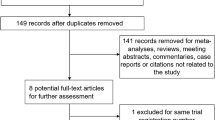Abstract
The objective of this study was to evaluate the clinical efficacy and safety of nitroprusside injection for preventing the slow-flow/no-reflow phenomenon after percutaneous coronary intervention (PCI). We searched the Cochrane Central Register of Controlled Trials (Issue 2, 2011), PubMed, EMbase, and Google Scholar for data. Two reviewers independently evaluated the quality of the included studies and extracted the data. A meta-analysis was performed using RevMan 5.0 software. Four randomized controlled trials (RCTs) involving 319 patients were included. The results of the meta-analyses showed that intracoronary nitroprusside is beneficial in preventing no-reflow/slow-flow, in reducing corrected TIMI frame count, and in improving left ventricular ejection fraction. It also likely reduces adverse reactions in patients after PCI and rehospitalization due to cardiovascular events. However, we must caution that in this review, there is a moderate possibility of bias with regard to patient selection, performance, and publication because of the small number of included studies. A larger sample size and high-quality RCTs are needed for a more reassuring analysis.




Similar content being viewed by others
References
Keeley, E. C., Boura, J. A., & Grines, C. L. (2003). Primary angioplasty versus intravenous thrombolytic therapy for acute myocardial infarction: A quantitative review of 23 randomised trials. Lancet, 361, 13–20.
Kloner, R. A., Ganote, C. E., & Jennings, R. B. (1974). The no-reflow phenomenon after temporary coronary occlusion in the dog. Journal of Clinical Investigation, 54, 1496–1508.
Kelly, R. V., Cohen, M. G., & Stouffer, G. A. (2005). Incidence and management of “no-reflow” following percutaneous coronary interventions. American Journal of the Medical Sciences, 329, 78–85.
Akdemir, R., Karakurt, O., Kilic, H., et al. (2010). Effect of reperfusion therapy on index of myocardial performance in acute myocardial infarction: Thrombolytics versus primary angioplasty. Heart and Vessels, 25, 87–91.
Bates, J. N., Baker, M. T., Guerra, R, Jr, & Harrison, D. G. (1991). Nitric oxide generation from nitroprusside by vascular tissue. Evidence that reduction of the nitroprusside anion and cyanide loss are required. Biochemical Pharmacology, 42(Suppl), S157–S165.
Pan, W., Wang, L. F., Yu, J. H., et al. (2009). Intracoronary nitroprusside in the prevention of the no-reflow phenomenon in acute myocardial infarction. Chinese Medical Journal, 122, 2718–2723.
Hendler, A., Aronovich, A., Kaluski, E., et al. (2006). Optimization of myocardial perfusion after primary coronary angioplasty following an acute myocardial infarction. Beyond TIMI 3 flow. Journal of Invasive Cardiology, 18, 32–36.
Amit, G., Cafri, C., Yaroslavtsev, S., et al. (2006). Intracoronary nitroprusside for the prevention of the no-reflow phenomenon after primary percutaneous coronary intervention in acute myocardial infarction. A randomized, double-blind, placebo-controlled clinical trial. American Heart Journal, 152, 887.e9–887.e14.
Sakamoto, H., Shimamoto, S., Kawase, Y., Ueda, H., Murakami, T., & Tamura, T. (2010). Effect of nitroprusside on reducing infarct size after primary percutaneous coronary intervention for acute myocardial infarction. Journal of the American College of Cardiology, 55, A104.E968.
Valero, S. J., Moreno, R., Reyes, R. M., et al. (2008). Pharmacological approach of no-reflow phenomenon related with percutaneous coronary interventions. Cardiovascular and Hematological Agents in Medicinal Chemistry, 6, 125–129.
Gibson, C. M., & Schomig, A. (2004). Coronary and myocardial angiography: Angiographic assessment of both epicardial and myocardial perfusion. Circulation, 109, 3096–3105.
Tesic, M. B., Stankovic, G., Vukcevic, V., & Ostojic, M. C. (2010). The use of intracoronary sodium nitroprusside to treat no-reflow after primary percutaneous coronary intervention in acute myocardial infarction. Herz, 35, 114–118.
Airoldi, F., Briguori, C., Cianflone, D., et al. (2007). Frequency of slow coronary flow following successful stent implantation and effect of nitroprusside. American Journal of Cardiology, 99, 916–920.
Pasceri, V., Pristipino, C., Pelliccia, F., et al. (2005). Effects of the nitric oxide donor nitroprusside on no-reflow phenomenon during coronary interventions for acute myocardial infarction. American Journal of Cardiology, 95, 1358–1361.
Kiernan, T. J., Ruggiero, N. J, I. I., Bernal, J. M., et al. (2009). The no-reflow phenomenon in the coronary circulation. Cardiovascular and Hematological Agents in Medicinal Chemistry, 7, 181–192.
Kitakaze, M., Asakura, M., Kim, J., et al. (2007). Human atrial natriuretic peptide and nicorandil as adjuncts to reperfusion treatment for acute myocardial infarction (J-WIND): Two randomised trials. Lancet, 370, 1483–1493.
Marzilli, M., Orsini, E., Marraccini, P., & Testa, R. (2000). Beneficial effects of intracoronary adenosine as an adjunct to primary angioplasty in acute myocardial infarction. Circulation, 101, 2154–2159.
Ross, A. M., Gibbons, R. J., Stone, G. W., Kloner, R. A., & Alexander, R. W. (2005). A randomized, double-blinded, placebo-controlled multicenter trial of adenosine as an adjunct to reperfusion in the treatment of acute myocardial infarction (AMISTAD-II). Journal of the American College of Cardiology, 45, 1775–1780.
Author information
Authors and Affiliations
Corresponding author
Rights and permissions
About this article
Cite this article
Su, Q., Li, L., Naing, K.A. et al. Safety and Effectiveness of Nitroprusside in Preventing No-Reflow During Percutaneous Coronary Intervention: A Systematic Review. Cell Biochem Biophys 68, 201–206 (2014). https://doi.org/10.1007/s12013-013-9690-9
Published:
Issue Date:
DOI: https://doi.org/10.1007/s12013-013-9690-9




